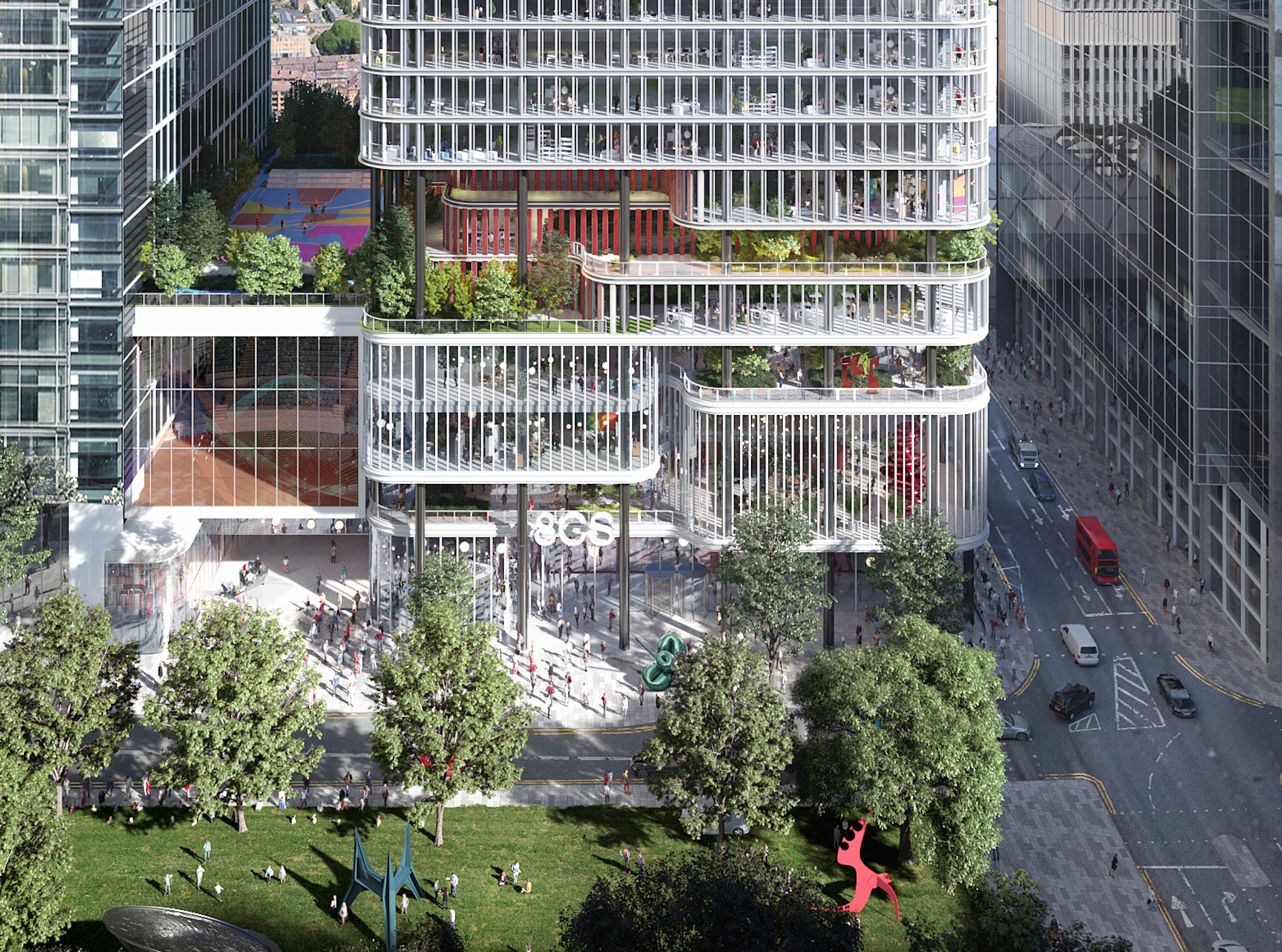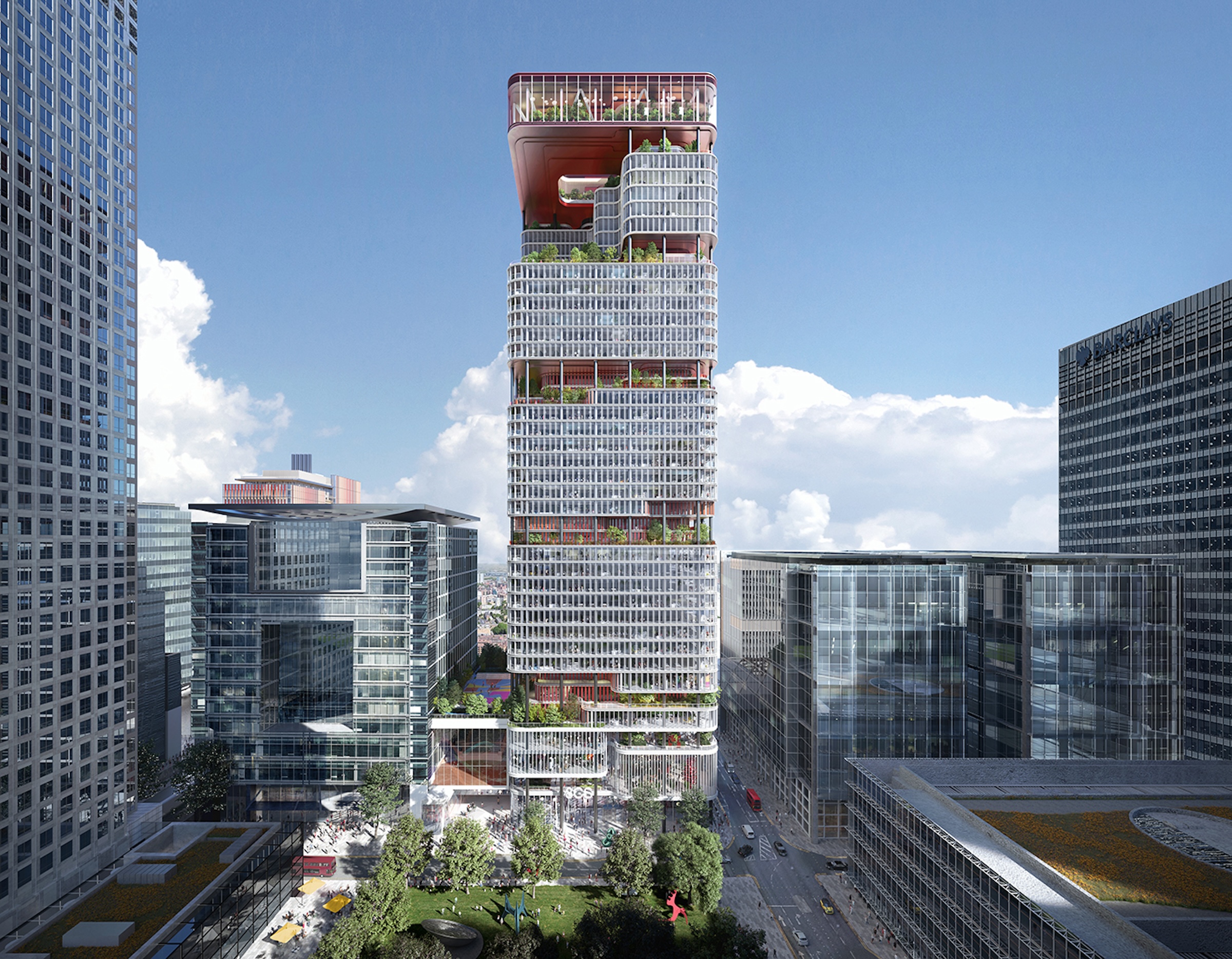8 Canada Square, a Norman Foster-designed office building that’s currently the global headquarters of HSBC Holdings, will have large sections of its façade removed to create landscaped terraces.
The project will be the world’s largest transformation of an office tower into a sustainable mixed-use building, according to a press statement from Qatar Investment Authority (QIA), which owns 8 Canada Square, and development partner Canary Wharf Group (CWG). The project is expected to start in 2027, after the current HSBC lease expires, and be completed in 2030.
QIA and CWG recently released the architectural plans for the redevelopment of 8 Canada Square, which is located in Canary Wharf, a London business district. In 2023, Canary Wharf saw an all-time high of 67.2 million visitors, according to the statement.
The design by Kohn Pedersen Fox (KPF), which won QIA and CWG’s global competition, reimagines the office tower as a mixed-use building. The project will create multiple green terraces and breakout spaces to provide access to daylight, views, social spaces, and fresh air. The 1.1 million sf, 42-story building will feature workspaces, leisure, entertainment, education, and cultural attractions.
The project will create a new publicly accessible route between the adjacent Elizabeth line station and Canada Square Park, while also offering views across London from Canary Wharf to the public for the first time.
The design concept plans to retain as much of the building’s existing material as possible to preserve embodied carbon and reduce whole life carbon. In collaboration with a range of consultants, the team intends to retain up to 70% of the original façade framing and up to 75% of the structure.
“This redevelopment is another step in Canary Wharf’s evolution into a vibrant mixed-use neighborhood offering workspace, retail, homes, leisure and amenities all in one location—a true 15-minute city,” Shobi Khan, CWG CEO, said in the statement.
KPF is working with the London Borough of Tower Hamlets, QIA, CWG, and the wider design team to develop plans and submit a planning application.

Here is the full press release from Canary Wharf Group:
Qatar Investment Authority (QIA) and Canary Wharf Group (CWG) have today released the first images of architectural plans that display the ambition for the redevelopment of the iconic 8 Canada Square building in Canary Wharf. 8 Canada Square is fully owned by QIA, and CWG is the development partner.
Kohn Pedersen Fox (KPF), the world-renowned architectural practice won a global competition run by QIA and CWG to reimagine the building. KPF will work with a market-leading team across design, engineering, planning and delivery on one of the world’s largest redevelopment projects. The project is set to begin in 2027, following the expiry of the current HSBC lease.
The images of the 1.1 million sq ft building demonstrate the transformation into a unique destination, which will include best-in-class workspaces, leisure, entertainment, education, and cultural attractions. The redevelopment will create a unique proposition for businesses within 8 Canada Square, with unparalleled sustainability credentials, excellent transport links and amenities. Set in the heart of Canary Wharf, the plans will enable a new publicly accessible route between the adjacent Elizabeth line station and Canada Square Park as well as offering the outstanding views across London from Canary Wharf to the public for the first time.
The investment from QIA to transform 8 Canada Square is a flagship example of the sovereign fund’s vision for multi-use real estate of the future, ensuring that the iconic building has world-class ESG credentials and meets the changing requirements of business for the long term.

The building’s changing shape will create a unique proposition for businesses within 8 Canada Square, with users also benefitting from being in Canary Wharf, where visitor numbers are at an all-time high with 67.2 million people visiting Canary Wharf during 2023.
Shobi Khan, CEO of CWG, added, “We look forward to working with QIA on 8 Canada Square to deliver a building of outstanding design, engineering and sustainability standards. This redevelopment is another step in Canary Wharf’s evolution into a vibrant mixed-use neighbourhood offering workspace, retail, homes, leisure and amenities all in one location – a true 15-minute city.”

Elie Gamburg, Design Principal at Kohn Pedersen Fox (KPF), said: “We are extremely excited to collaborate with QIA and CWG to reimagine the single-use office building as a blueprint for the highly sustainable, mixed-use building of the future. This transformation embodies the ethos behind much of our work, we see it as an integral part of the evolution of today’s single-use neighbourhoods into vibrant mixed-use neighborhoods of tomorrow – an evolution of which CWG is already leading the way.”
CWG and QIA will be working with the London Borough of Tower Hamlets and the appointed team to develop plans and submit a planning application.
Related Stories
Urban Planning | Jul 26, 2023
America’s first 100% electric city shows the potential of government-industry alignment
Ithaca has turned heads with the start of its latest venture: Fully decarbonize and electrify the city by 2030.
Multifamily Housing | Jul 25, 2023
San Francisco seeks proposals for adaptive reuse of underutilized downtown office buildings
The City of San Francisco released a Request For Interest to identify office building conversions that city officials could help expedite with zoning changes, regulatory measures, and financial incentives.
Sustainability | Jul 13, 2023
Deep green retrofits: Updating old buildings to new sustainability standards
HOK’s David Weatherhead and Atenor’s Eoin Conroy discuss the challenges and opportunities of refurbishing old buildings to meet modern-day sustainability standards.
Multifamily Housing | Jul 11, 2023
Converting downtown office into multifamily residential: Let’s stop and think about this
Is the office-to-residential conversion really what’s best for our downtowns from a cultural, urban, economic perspective? Or is this silver bullet really a poison pill?
Adaptive Reuse | Jul 10, 2023
California updates building code for adaptive reuse of office, retail structures for housing
The California Building Standards Commission recently voted to make it easier to convert commercial properties to residential use. The commission adopted provisions of the International Existing Building Code (IEBC) that allow developers more flexibility for adaptive reuse of retail and office structures.
Adaptive Reuse | Jul 6, 2023
The responsibility of adapting historic university buildings
Shepley Bulfinch's David Whitehill, AIA, believes the adaptive reuse of historic university buildings is not a matter of sentimentality but of practicality, progress, and preservation.
Multifamily Housing | Jun 19, 2023
Adaptive reuse: 5 benefits of office-to-residential conversions
FitzGerald completed renovations on Millennium on LaSalle, a 14-story building in the heart of Chicago’s Loop. Originally built in 1902, the former office building now comprises 211 apartment units and marks LaSalle Street’s first complete office-to-residential conversion.
Multifamily Housing | May 23, 2023
One out of three office buildings in largest U.S. cities are suitable for residential conversion
Roughly one in three office buildings in the largest U.S. cities are well suited to be converted to multifamily residential properties, according to a study by global real estate firm Avison Young. Some 6,206 buildings across 10 U.S. cities present viable opportunities for conversion to residential use.
Multifamily Housing | May 16, 2023
Legislators aim to make office-to-housing conversions easier
Lawmakers around the country are looking for ways to spur conversions of office space to residential use.cSuch projects come with challenges such as inadequate plumbing, not enough exterior-facing windows, and footprints that don’t easily lend themselves to residential use. These conditions raise the cost for developers.
Sustainability | May 11, 2023
Let's build toward a circular economy
Eric Corey Freed, Director of Sustainability, CannonDesign, discusses the values of well-designed, regenerative buildings.

















